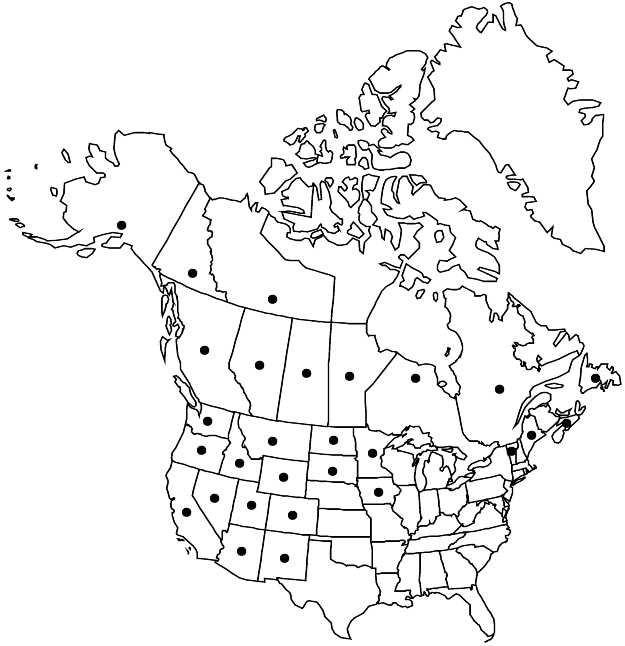Rumex occidentalis
Proc. Amer. Acad. Arts 12: 253. 1877.
Plants perennial, glabrous or very indistinctly papillose, especially on veins of leaf-blades abaxially, with fusiform, vertical or oblique rootstock. Stems usually erect, branched from above middle or in distal 2/3, 50–100 (–140) cm. Leaves: ocrea deciduous or partially persistent at maturity; blade narrowly ovate-triangular, ovatelanceolate, or oblong-lanceolate, normally 10–35 × 5–12 cm, base weakly to distinctly cordate, truncate, or rounded, margins entire, undulate or indistinctly crisped, apex acute or subacute, rarely obtuse. Inflorescences terminal, occupying distal 2/3 of stem, dense to interrupted, narrowly paniculate, often repeatedly branched (branches usually more than 7–8 cm). Pedicels articulated in proximal 1/3, filiform, 5–13 (–17) mm, normally not more than 2–2.5 times as long as inner tepals, articulation weakly evident, not swollen. Flowers mostly 12–25 in whorls; inner tepals orbiculate, ovate, or broadly ovate-triangular, 5–10 (–12) × 5–8 (–11) mm, base truncate to weakly cordate, margins entire or subentire to very weakly erose, apex obtuse or subacute; tubercles absent. Achenes reddish-brown, 3–4.5 (–4.8) × 1.5–2.5 mm. 2n = 120.
Phenology: Flowering late spring–summer.
Habitat: Wet meadows, bogs, marshes, river banks, shallow water, other wet habitats
Elevation: 0-2500(-3000) m
Distribution

Alta., B.C., Man., Nfld. and Labr. (Nfld.), N.W.T., N.S., Ont., Que., Sask., Yukon, Alaska, Ariz., Calif., Colo., Idaho, Iowa, Maine, Minn., Mont., Nev., N.Mex., N.Dak., Oreg., S.Dak., Utah, Vt., Wash., Wyo.
Discussion
In the nineteenth century, Rumex occidentalis commonly was misidentified as R. aquaticus, R. longifolius, or R. domesticus.
All of the species of subsect. Aquatici Rechinger f., represented in North America by Rumex occidentalis, R. arcticus, R. nematopodus, and R. tomentellus, form a taxonomically complex aggregate with poorly delimited, often intergrading species. Extremes are evidently distinct (e.g., R. arcticus and R. tomentellus). The taxonomy and distribution of members of this aggregate are still insufficiently known. Some authors prefer to treat all or most of these taxa as subspecies or varieties of R. aquaticus in the broad sense. From my point of view, this does not promote a better understanding of their variability and relationships.
A number of segregate species have been described and recognized in regional floras in North America. In most cases the features upon which these species are based intergrade. One of the most widely recognized segregates is Rumex fenestratus Greene emend. Rechinger f. [R. aquaticus subsp. fenestratus (Greene) Hultén, R. occidentalis S. Watson subsp. fenestratus (Greene) Hultén], which, according to K. H. Rechinger (1937), may be distinguished mostly by larger and more cordate fruiting inner tepals (more than 7 mm in R. fenestratus, usually less than 7 mm in R. occidentalis), and larger achenes (3 mm, and more than 3.5 mm, respectively). The morphotype of R. fenestratus occurs mostly along the Pacific coast from central western California to Alaska. Plants with large fruiting inner tepals [known as R. fenestratus var. labradoricus Rechinger f. or R. occidentalis var. labradoricus (Rechinger f.) Lepage] occur also in eastern Canada (Newfoundland and Quebec). In this treatment, I follow the taxonomic decision by J. E. Dawson (1979), who carefully analyzed the clinal variability of the R. occidentalis aggregate. However, R. fenestratus probably deserves recognition at least as a subspecies of R. occidentalis, but its taxonomic status needs additional investigation.
Rumex occidentalis was reported also from New Brunswick (which seems to be a rather natural extension of its range); however, the present status of the species in that province is uncertain.
Selected References
None.
Lower Taxa
"/2" is not declared as a valid unit of measurement for this property."+-2.5timesaslongasinnertepals" is not declared as a valid unit of measurement for this property.
